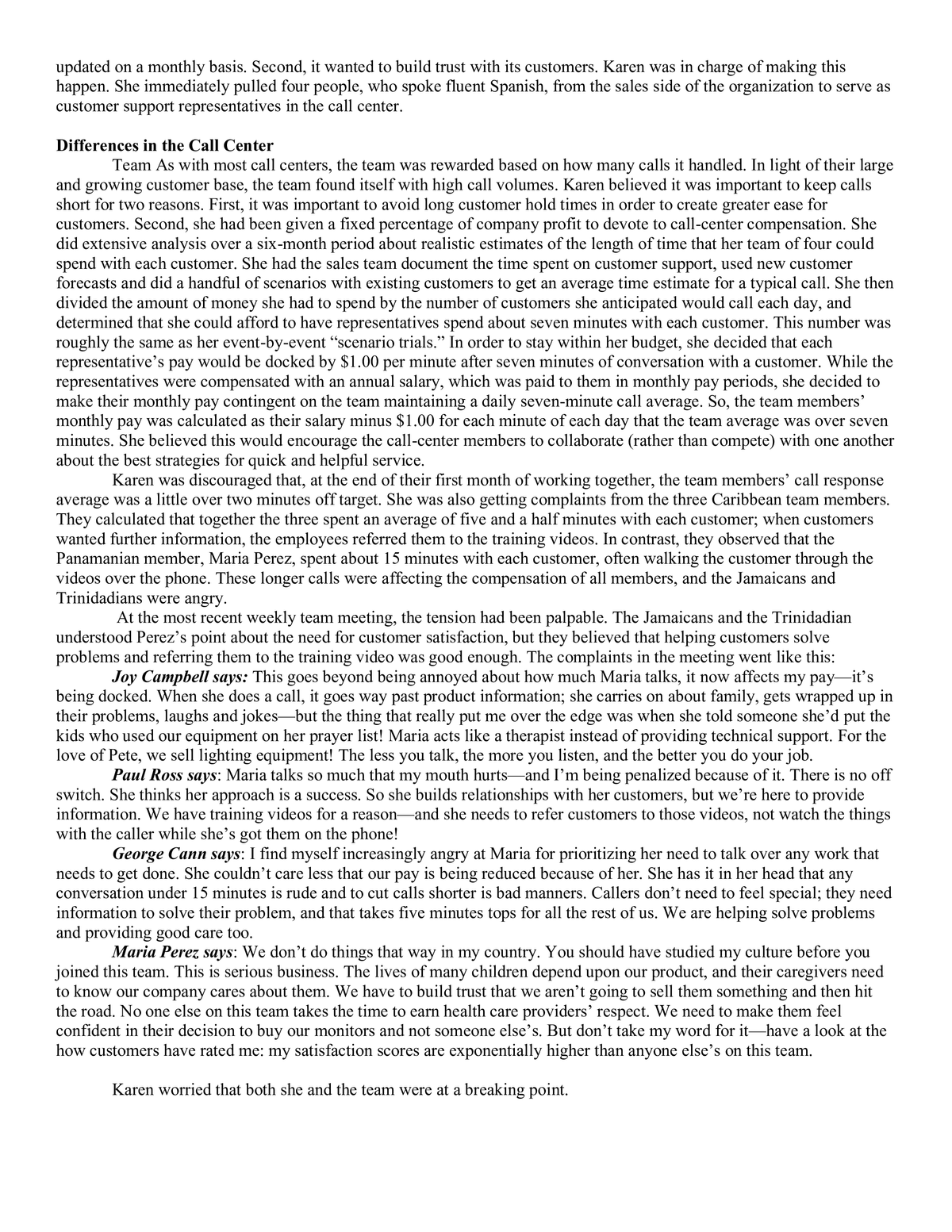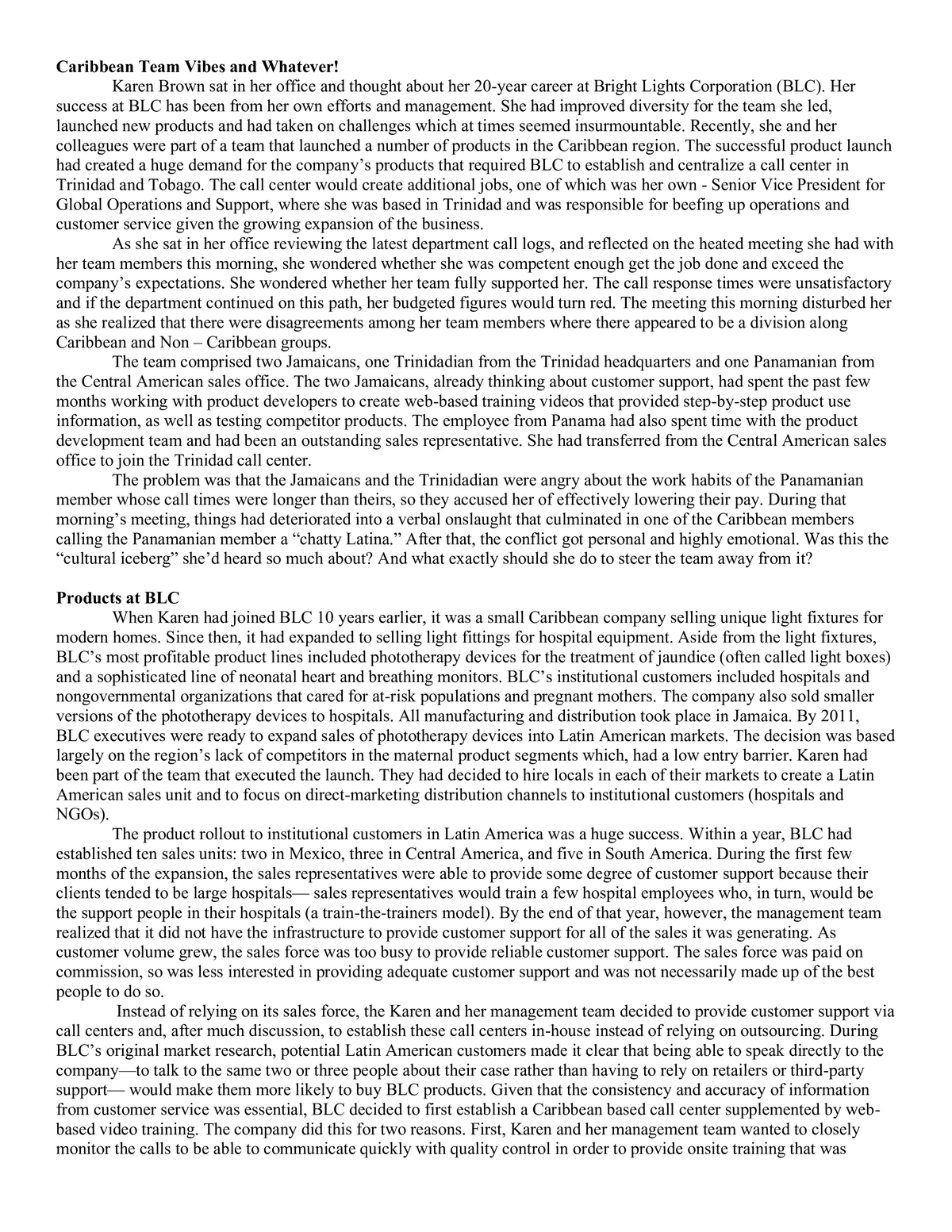Management, Loose-Leaf Version
13th Edition
ISBN:9781305969308
Author:Richard L. Daft
Publisher:Richard L. Daft
Chapter9: Managerial Decision Making
Section: Chapter Questions
Problem 1ED
Related questions
Question
1. What is your assessment of Karen’s leadership style?
2. What two leadership practices she did or did not do well in the case?

Transcribed Image Text:updated on a monthly basis. Second, it wanted to build trust with its customers. Karen was in charge of making this
happen. She immediately pulled four people, who spoke fluent Spanish, from the sales side of the organization to serve as
customer support representatives in the call center.
Differences in the Call Center
Team As with most call centers, the team was rewarded based on how many calls it handled. In light of their large
and growing customer base, the team found itself with high call volumes. Karen believed it was important to keep calls
short for two reasons. First, it was important to avoid long customer hold times in order to create greater ease for
customers. Second, she had been given a fixed percentage of company profit to devote to call-center compensation. She
did extensive analysis over a six-month period about realistic estimates of the length of time that her team of four could
spend with each customer. She had the sales team document the time spent on customer support, used new customer
forecasts and did a handful of scenarios with existing customers to get an average time estimate for a typical call. She then
divided the amount of money she had to spend by the number of customers she anticipated would call each day, and
determined that she could afford to have representatives spend about seven minutes with each customer. This number was
roughly the same as her event-by-event "scenario trials." In order to stay within her budget, she decided that each
representative's pay would be docked by $1.00 per minute after seven minutes of conversation with a customer. While the
representatives were compensated with an annual salary, which was paid to them in monthly pay periods, she decided to
make their monthly pay contingent on the team maintaining a daily seven-minute call average. So, the team members'
monthly pay was calculated as their salary minus $1.00 for each minute of each day that the team average was over seven
minutes. She believed this would encourage the call-center members to collaborate (rather than compete) with one another
about the best strategies for quick and helpful service.
Karen was discouraged that, at the end of their first month of working together, the team members' call response
average was a little over two minutes off target. She was also getting complaints from the three Caribbean team members.
They calculated that together the three spent an average of five and a half minutes with each customer; when customers
wanted further information, the employees referred them to the training videos. In contrast, they observed that the
Panamanian member, Maria Perez, spent about 15 minutes with each customer, often walking the customer through the
videos over the phone. These longer calls were affecting the compensation of all members, and the Jamaicans and
Trinidadians were angry.
At the most recent weekly team meeting, the tension had been palpable. The Jamaicans and the Trinidadian
understood Perez's point about the need for customer satisfaction, but they believed that helping customers solve
problems and referring them to the training video was good enough. The complaints in the meeting went like this:
Joy Campbell says: This goes beyond being annoyed about how much Maria talks, it now affects my pay it's
being docked. When she does a call, it goes way past product information; she carries on about family, gets wrapped up in
their problems, laughs and jokes—but the thing that really put me over the edge was when she told someone she'd put the
kids who used our equipment on her prayer list! Maria acts like a therapist instead of providing technical support. For the
love of Pete, we sell lighting equipment! The less you talk, the more you listen, and the better you do your job.
Paul Ross says: Maria talks so much that my mouth hurts—and I'm being penalized because of it. There is no off
switch. She thinks her approach is a success. So she builds relationships with her customers, but we're here to provide
information. We have training videos for a reason and she needs to refer customers to those videos, not watch the things
with the caller while she's got them on the phone!
George Cann says: I find myself increasingly angry at Maria for prioritizing her need to talk over any work that
needs to get done. She couldn't care less that our pay is being reduced because of her. She has it in her head that any
conversation under 15 minutes is rude and to cut calls shorter is bad manners. Callers don't need to feel special; they need
information to solve their problem, and that takes five minutes tops for all the rest of us. We are helping solve problems
and providing good care too.
Maria Perez, says: We don't do things that way in my country. You should have studied my culture before you
joined this team. This is serious business. The lives of many children depend upon our product, and their caregivers need
to know our company cares about them. We have to build trust that we aren't going to sell them something and then hit
the road. No one else on this team takes the time to earn health care providers' respect. We need to make them feel
confident in their decision to buy our monitors and not someone else's. But don't take my word for it-have a look at the
how customers have rated me: my satisfaction scores are exponentially higher than anyone else's on this team.
Karen worried that both she and the team were at a breaking point.

Transcribed Image Text:Caribbean Team Vibes and Whatever!
Karen Brown sat in her office and thought about her 20-year career at Bright Lights Corporation (BLC). Her
success at BLC has been from her own efforts and management. She had improved diversity for the team she led,
launched new products and had taken on challenges which at times seemed insurmountable. Recently, she and her
colleagues were part of a team that launched a number of products in the Caribbean region. The successful product launch
had created a huge demand for the company's products that required BLC to establish and centralize a call center in
Trinidad and Tobago. The call center would create additional jobs, one of which was her own - Senior Vice President for
Global Operations and Support, where she was based in Trinidad and was responsible for beefing up operations and
customer service given the growing expansion of the business.
As she sat in her office reviewing the latest department call logs, and reflected on the heated meeting she had with
her team members this morning, she wondered whether she was competent enough get the job done and exceed the
company's expectations. She wondered whether her team fully supported her. The call response times were unsatisfactory
and if the department continued on this path, her budgeted figures would turn red. The meeting this morning disturbed her
as she realized that there were disagreements among her team members where there appeared to be a division along
Caribbean and Non - Caribbean groups.
The team comprised two Jamaicans, one Trinidadian from the Trinidad headquarters and one Panamanian from
the Central American sales office. The two Jamaicans, already thinking about customer support, had spent the past few
months working with product developers to create web-based training videos that provided step-by-step product use
information, as well as testing competitor products. The employee from Panama had also spent time with the product
development team and had been an outstanding sales representative. She had transferred from the Central American sales
office to join the Trinidad call center.
The problem was that the Jamaicans and the Trinidadian were angry about the work habits of the Panamanian
member whose call times were longer than theirs, so they accused her of effectively lowering their pay. During that
morning's meeting, things had deteriorated into a verbal onslaught that culminated in one of the Caribbean members
calling the Panamanian member a “chatty Latina.” After that, the conflict got personal and highly emotional. Was this the
"cultural iceberg" she'd heard so much about? And what exactly should she do to steer the team away from it?
Products at BLC
When Karen had joined BLC 10 years earlier, it was a small Caribbean company selling unique light fixtures for
modern homes. Since then, it had expanded to selling light fittings for hospital equipment. Aside from the light fixtures,
BLC's most profitable product lines included phototherapy devices for the treatment of jaundice (often called light boxes)
and a sophisticated line of neonatal heart and breathing monitors. BLC's institutional customers included hospitals and
nongovernmental organizations that cared for at-risk populations and pregnant mothers. The company also sold smaller
versions of the phototherapy devices to hospitals. All manufacturing and distribution took place in Jamaica. By 2011,
BLC executives were ready to expand sales of phototherapy devices into Latin American markets. The decision was based
largely on the region's lack of competitors in the maternal product segments which, had a low entry barrier. Karen had
been part of the team that executed the launch. They had decided to hire locals in each of their markets to create a Latin
American sales unit and to focus on direct-marketing distribution channels to institutional customers (hospitals and
NGOs).
The product rollout to institutional customers in Latin America was a huge success. Within a year, BLC had
established ten sales units: two in Mexico, three in Central America, and five in South America. During the first few
months of the expansion, the sales representatives were able to provide some degree of customer support because their
clients tended to be large hospitals- sales representatives would train a few hospital employees who, in turn, would be
the support people in their hospitals (a train-the-trainers model). By the end of that year, however, the management team
realized that it did not have the infrastructure to provide customer support for all of the sales it was generating. As
customer volume grew, the sales force was too busy to provide reliable customer support. The sales force was paid on
commission, so was less interested in providing adequate customer support and was not necessarily made up of the best
people to do so.
Instead of relying on its sales force, the Karen and her management team decided to provide customer support via
call centers and, after much discussion, to establish these call centers in-house instead of relying on outsourcing. During
BLC's original market research, potential Latin American customers made it clear that being able to speak directly to the
company to talk to the same two or three people about their case rather than having to rely on retailers or third-party
support- would make them more likely to buy BLC products. Given that the consistency and accuracy of information
from customer service was essential, BLC decided to first establish a Caribbean based call center supplemented by web-
based video training. The company did this for two reasons. First, Karen and her management team wanted to closely
monitor the calls to be able to communicate quickly with quality control in order to provide onsite training that was
Expert Solution
This question has been solved!
Explore an expertly crafted, step-by-step solution for a thorough understanding of key concepts.
Step by step
Solved in 2 steps

Recommended textbooks for you

Management, Loose-Leaf Version
Management
ISBN:
9781305969308
Author:
Richard L. Daft
Publisher:
South-Western College Pub

Management, Loose-Leaf Version
Management
ISBN:
9781305969308
Author:
Richard L. Daft
Publisher:
South-Western College Pub